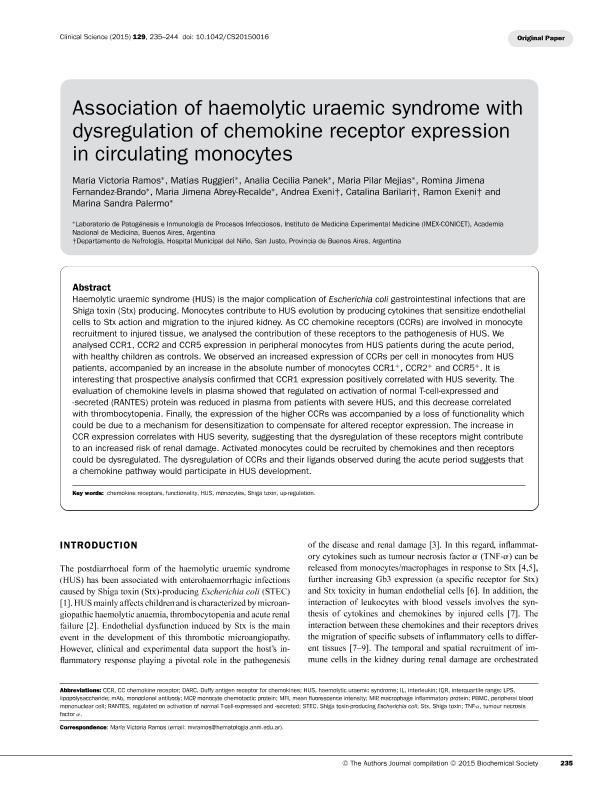Artículo
Association of haemolytic uraemic syndrome with dysregulation of chemokine receptor expression in circulating monocytes
Ramos, Maria Victoria ; Ruggieri, Matias
; Ruggieri, Matias ; Panek, Cecilia Analía
; Panek, Cecilia Analía ; Mejias, María Pilar
; Mejias, María Pilar ; Fernández Brando, Romina Jimena
; Fernández Brando, Romina Jimena ; Abrey Recalde, Maria Jimena
; Abrey Recalde, Maria Jimena ; Exeni, Andrea; Barilari, Catalina; Exeni, Ramon; Palermo, Marina Sandra
; Exeni, Andrea; Barilari, Catalina; Exeni, Ramon; Palermo, Marina Sandra
 ; Ruggieri, Matias
; Ruggieri, Matias ; Panek, Cecilia Analía
; Panek, Cecilia Analía ; Mejias, María Pilar
; Mejias, María Pilar ; Fernández Brando, Romina Jimena
; Fernández Brando, Romina Jimena ; Abrey Recalde, Maria Jimena
; Abrey Recalde, Maria Jimena ; Exeni, Andrea; Barilari, Catalina; Exeni, Ramon; Palermo, Marina Sandra
; Exeni, Andrea; Barilari, Catalina; Exeni, Ramon; Palermo, Marina Sandra
Fecha de publicación:
08/2015
Editorial:
Portland Press
Revista:
Clinical Science
ISSN:
0143-5221
Idioma:
Inglés
Tipo de recurso:
Artículo publicado
Clasificación temática:
Resumen
Haemolytic uraemic syndrome (HUS) is the major complication of Escherichia coli gastrointestinal infections that are Shiga toxin (Stx) producing. Monocytes contribute to HUS evolution by producing cytokines that sensitize endothelial cells to Stx action and migration to the injured kidney. As CC chemokine receptors (CCRs) are involved in monocyte recruitment to injured tissue, we analysed the contribution of these receptors to the pathogenesis of HUS. We analysed CCR1, CCR2 and CCR5 expression in peripheral monocytes from HUS patients during the acute period, with healthy children as controls. We observed an increased expression of CCRs per cell in monocytes from HUS patients, accompanied by an increase in the absolute number of monocytes CCR1+, CCR2+ and CCR5+. It is interesting that prospective analysis confirmed that CCR1 expression positively correlated with HUS severity. The evaluation of chemokine levels in plasma showed that regulated on activation of normal T-cell-expressed and -secreted (RANTES) protein was reduced in plasma from patients with severe HUS, and this decrease correlated with thrombocytopenia. Finally, the expression of the higher CCRs was accompanied by a loss of functionality which could be due to a mechanism for desensitization to compensate for altered receptor expression. The increase in CCR expression correlates with HUS severity, suggesting that the dysregulation of these receptors might contribute to an increased risk of renal damage. Activated monocytes could be recruited by chemokines and then receptors could be dysregulated. The dysregulation of CCRs and their ligands observed during the acute period suggests that a chemokine pathway would participate in HUS development.
Palabras clave:
CHEMOKINE RECEPTORS
,
FUNCTIONALITY
,
HUS
,
MONOCYTES
,
SHIGA TOXIN
,
UP-REGULATION
Archivos asociados
Licencia
Identificadores
Colecciones
Articulos(IMEX)
Articulos de INST.DE MEDICINA EXPERIMENTAL
Articulos de INST.DE MEDICINA EXPERIMENTAL
Citación
Ramos, Maria Victoria; Ruggieri, Matias; Panek, Cecilia Analía; Mejias, María Pilar; Fernández Brando, Romina Jimena; et al.; Association of haemolytic uraemic syndrome with dysregulation of chemokine receptor expression in circulating monocytes; Portland Press; Clinical Science; 129; 3; 8-2015; 235-244
Compartir
Altmétricas



